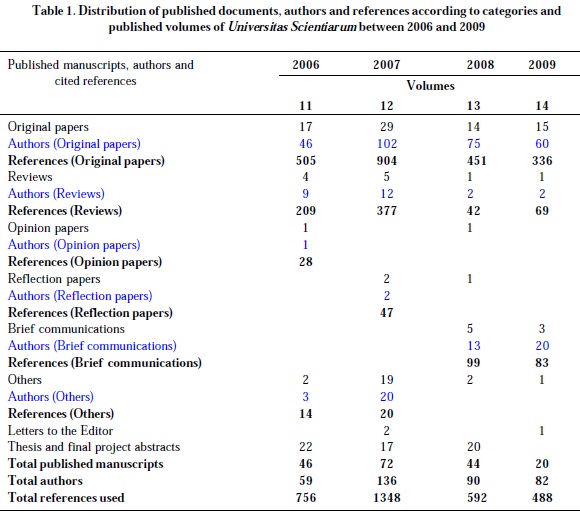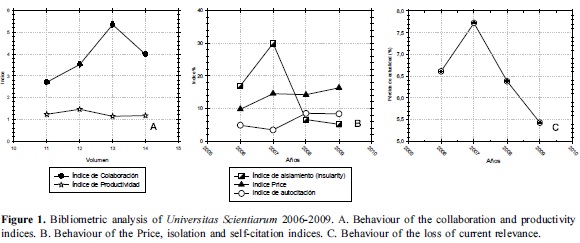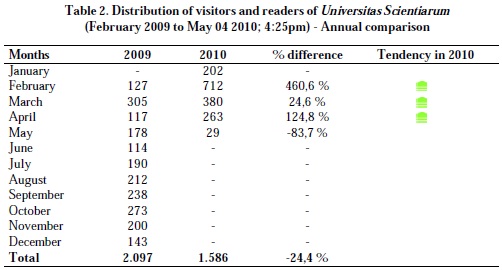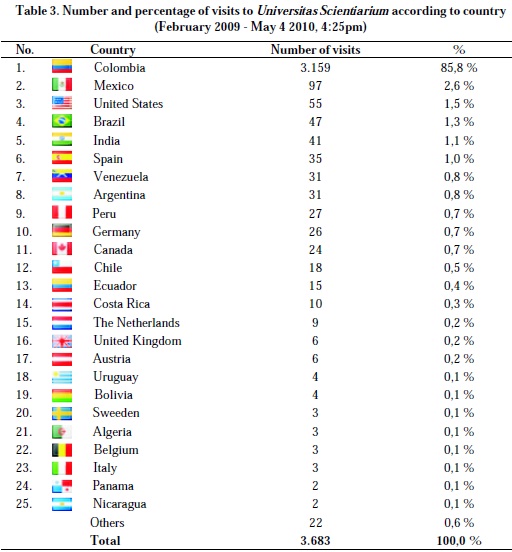Servicios Personalizados
Revista
Articulo
Indicadores
-
 Citado por SciELO
Citado por SciELO -
 Accesos
Accesos
Links relacionados
-
 Citado por Google
Citado por Google -
 Similares en
SciELO
Similares en
SciELO -
 Similares en Google
Similares en Google
Compartir
Universitas Scientiarum
versión impresa ISSN 0122-7483
Univ. Sci. v.15 n.1 Bogotá ene./abr. 2010
How are we progressing and towards what direction in Universitas Scientiarum?
Dear researchers, students and readers of Universitas Scientiarum,
The first study on bibliometric indicators of our journal was published in number 3 of volume 13. In that article we showed an analysis from 1987 to 2007 in relation to indicators such as productivity index (PI), collaboration index (CI), Price index, obsolescence, isolation (II), self-citation (SCR), among others (1). Conclusions of the article show a path to be followed and some points to be considered in order to increase the visibility of Universitas Scientiarum (2).
The present editorial shows to the scientific community what has been achieved with the measures adopted and what has been done after the first bibliometric analysis. Table 1 shows the numeric distribution of the documents published in Universitas Scientiarum from 2006 to 2009. It can be seen that abstracts of degree projects and theses have been reduced to cero, that the number of original articles remains stable and that the number of review articles diminished since reviews began to be done by invitation. On the other hand, opinion and reflection papers were eliminated and short communications were included as an option for publishing non original works of high quality and importance.

Analyzing and comparing the last four volumes of Universitas Scientiarum, in relation to the bibliometric indicators figure 1B shows that with the strategies of restriction to the age of cited references, the type of reference and the number of references used, the Isolation Index was reduced in more than 20%, the SCR index was maintained and the Price index began to rise, as well as to reduce the loss of current relevance from 7.7% (2007) to 5.5% (2009) (Figure 1C). The Productivity Index (PI) has remained stable while the collaboration index (CI) has lowered because not all the articles accepted in 2008 and 2009 were original (Figure 1A, Table 1). This is an important consideration because as it was the case with the article on bibliometry previously published in 2008 (1), results show only the analysis of the original articles with the purpose of rendering them comparable. Nevertheless, future studies will have to analyze the other categories of scientific documents published in Universitas Scientiarum.

At the beginning of 2009 and thanks to the work done by the editorial committee of Universitas Scientiarum headed by Dr Yuri Orlik, we were accepted by Scopus. We are now visible with issues of volume 14 2009 [14(1) and 14(2-3)], what will improve without a doubt our visibility and will increase the number of international manuscripts sent for publication in Universitas Scientiarum.


We are currently preparing the documentation to obtain the classification of the journal in the National Bibliographic Index (Publindex) and we continue with the hope that the process that we have been carrying out with the help of all of you will allow us to reach the A category.
Finally, we are pleased to inform that the past month we submitted the journal to ISI (Thompson Reuters, USA) and were placed in the test period for an approximate period of 1.5 years. It is clear that the quality, periodicity and punctuality that we can maintain in Universitas Scientiarum are what will allow us to be accepted. To achieve this goal, we require that you researchers disseminate the results of your research in Universitas Scientiarum, that you reviewers and referees be every time more and more demanding, more precise in your opinions, that all of us respect to the highest extent the timings of each stage of the editorial process, and that readers read us with a critical eye.
I take the opportunity to acknowledge the work done during the organization of the documentation for the submittal of the journal to ISI, to: Ms Sandra Constantino (reviewer of the English language), Dr Jorge Jácome (co-editor), Dr Alberto Acosta (editorial committee), Ms María Alejandra Tejada (coordinator of serial publications, PUJ), and Mrs Nigza Ramírez; without your effort and commitment we would not be in the test period of ISI. Without any doubt the support provided by Dr Ingrid Schuler (Academic Dean) and the other members of the committees (Editorial, Thematic Co-Editors, and Scientific) has helped us to reach this point.
We still have many things to improve, but we should point out that the rejection index of Universitas Scientiarum has increased up to 50% and should continue increasing with the demands of our reviewers, the endogamy in the reviewing process has been reduced down to 2%, and the response time for acceptance or rejection of a submitted manuscript is approximately 2 months.
On behalf of the editorial committee of Universitas Scientiarum, I would like to invite you all to publish in our journal, we have a promising future with 100% of growth opportunities.
Raúl A. Poutou-Piñales, PhD
Associate Professor
Editor-in-Chief
References
1. Escorcia TA, Poutou RA. Análisis bibliométrico de los artículos originales publicados en la revista Universitas Scientiarum (1987-2007), Universitas 2008; 13 (3): 236-244.
2. Camps D. El análisis bibliométrico de Universitas Scientarium, Universitas Scientiarum 2009; 14 (1): 5-7.
1. Escorcia TA, Poutou RA. Análisis bibliométrico de los artículos originales publicados en la revista Universitas Scientiarum (1987-2007), Universitas Scientiarum 2008; 13 (3): 236-244. [ Links ]
2. Camps D. El análisis bibliométrico de Universitas Scientarium, Universitas Scientiarum 2009; 14 (1): 5-7. [ Links ]











 texto en
texto en 


